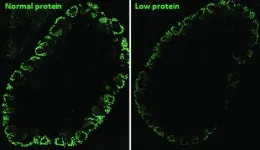What is driving reductions in residential greenhouse gas emissions in the US?
A study from Yale School of the Environment finds smarter home construction and decarbonization of electric supply are contributing to lower emissions from individual households, but trends show other factors could begin to cancel out this progress
2021-05-05
(Press-News.org) In 2005, greenhouse gas (GHG) emissions from residential energy use hit an all-time high in the United States. Each year since, emissions have dropped at an average annual rate of 2 percent.
In a study published in Environmental Research Letters, "Drivers of change in US residential energy consumption and greenhouse gas emissions, 1990-2015," a team of researchers from the Yale School of the Environment (YSE) outlined several factors that have contributed to this decrease, highlighting efficiencies in new home construction, energy consumption and household appliances, as well as less emissions in electric generation.
"Without the reductions in GHG intensity of electricity, residential GHG emissions would have been higher," growing by 30 percent from 1990 to 2015 rather than the current 6 percent, says YSE PhD student Peter Berrill from the Center for Industrial Ecology, who co-authored the paper with Ken Gillingham, associate professor of economics at YSE, and former YSE faculty member Edgar Hertwich.
Using detailed data gathered from multiple U.S. housing surveys and energy reviews, Berrill found positives in less GHG-intensive electricity, but added that it's "too risky" to rely on only electricity to decarbonize the residential sector in the coming decades. This, he says, is due to other troubling trends: population growth; reduction of household size, including more senior citizens living on their own; substantial increases in floor area per house in recent decades; and increased access to residential cooling.
To stem the tide against those trends, Berrill sees a need for societal change.
"Without it, we're not going to see meaningful change," he says. More attention needs to be paid, says Berrill, to building smaller homes, including more multi-family housing, and retrofitting existing homes to be more efficient. He also suggested regional approaches -- for example, population growth is slower in the Northeast and Midwest, and more attention needs to be paid to renovating and retrofitting older homes in areas with slowly growing housing stock.
Berrill, Gillingham and Hertwich also authored a related paper recently published in Environmental Science Technology, focused on how housing policy and types of housing are linked to residential energy demand. The researchers analyzed federal policy changes in the 1970s and 1980s that increased single-family housing construction considerably -- an estimated 14 million new homes by 2015, leading to a greater need for heating and cooling, water and electricity.
The researchers estimate that a shift from single-family housing to multi-family housing could reduce energy demand by as much as 47 percent per household and more than 8 percent across the entire U.S. housing stock.
"Removing policy barriers and disincentives to multifamily housing can unlock a large potential for reducing residential energy demand and GHG emissions in the coming decades," the researchers say.
INFORMATION:
ELSE PRESS RELEASES FROM THIS DATE:
2021-05-05
(Philadelphia, PA) - For patients with chronic pain, ineffective treatments, lowered work productivity, and other factors often coalesce, fueling feelings of hopelessness and anxiety and setting the stage for even bigger problems, including substance use disorders. In 2017 alone, some 18 million Americans misused prescription pain relievers over the course of the previous year. In many of these instances, patients suffering from chronic pain became addicted to prescription opioids.
In addition to being highly addictive, many studies suggest that prescription opioids do not effectively control pain over the long term, and hence researchers ...
2021-05-05
Many people with diabetes endure multiple, painful finger pricks each day to measure their blood glucose. Now, researchers reporting in ACS Sensors have developed a device that can measure glucose in sweat with the touch of a fingertip, and then a personalized algorithm provides an accurate estimate of blood glucose levels.
According to the American Diabetes Association, more than 34 million children and adults in the U.S. have diabetes. Although self-monitoring of blood glucose is a critical part of diabetes management, the pain and inconvenience caused ...
2021-05-05
At the beginning of the COVID-19 pandemic, intense social distancing and lockdown measures were the primary weapon in the fight against the spread of SARS-CoV-2, but they came with a monumental societal burden. New research from the Center for the Ecology of Infectious Diseases and the College of Public Health at the University of Georgia explores if there could have been a better way.
Published in the journal Proceedings of the Royal Society B, the research analyzes more palatable alternatives to the kind of social distancing mandates that threw a wrench at how businesses, schools ...
2021-05-05
A study published in July 2020 hypothesized a link between the presence of bradykinin, a well-known peptide, and severe cases of COVID-19. Vardan Karamyan, Ph.D., an associate professor and vice chair for the Texas Tech University Health Sciences Center (TTUHSC) Jerry H. Hodge School of Pharmacy Department of Pharmaceutical Sciences, had not previously conducted or evaluated any research related to COVID-19. However, he found the article intriguing because it discussed bradykinin, one of three specific peptides with which his lab has much well-published experience.
The paper received a lot of attention in both the media and scientific literature, but as Karamyan read through it, he felt it failed to address an equally important part of a bigger picture: the likely ...
2021-05-05
A new service piloted at Penn Medicine allowed a proportion of patients to avoid hospitalization by providing them with greater support after visiting the emergency department. The vast majority of the patients enrolled in the service - nearly 9 out of 10 - did not need to return to the hospital for care in the month that followed their initial visit. The study was published in Healthcare.
"The culture is shifting where we realize that hospitalization is not always the best option for patients - particularly patients with chronic illness," said one of the study's lead authors, Austin Kilaru, MD, an emergency physician at Penn Medicine. "We need to find better ways of helping patients not just get healthy in a hospital, but stay healthy at ...
2021-05-05
Leather is an ever growing multi-billion dollar industry requiring more than 3.8 billion bovine animals - equal to one for every two people on earth - to sustain production each year. And while the products - clothing, shoes, furniture and more - can be quite elegant and durable, the environmental impact of leather production has been severe, leading to deforestation, water and land overuse, environmental pollution, and greenhouse gas emissions.
Researchers at Tufts University School of Engineering set out to find an alternative to leather, with similar texture, flexibility and stiffness, yet focused on materials that are sustainable, non-toxic, and friendly to the environment. It turns out, we have been wearing that material ...
2021-05-05
PITTSBURGH, May 5, 2021 - Subtle differences in the shape of the brain that are present in adolescence are associated with the development of psychosis, according to an international team led by neuroscientists at the University of Pittsburgh School of Medicine and Maastricht University in the Netherlands.
In results published today in JAMA Psychiatry, the differences are too subtle to detect in an individual or use for diagnostic purposes. But the findings could contribute to ongoing efforts to develop a cumulative risk score for psychosis that would allow for earlier detection and treatment, as well as targeted therapies. The discovery was made with the largest-ever ...
2021-05-05
Besides being underweight, babies born to women whose diet lacked sufficient protein during pregnancy tend to have kidney problems resulting from alterations that occurred while their organs were forming during the embryonic stage of their development.
In a study published in PLOS ONE, researchers affiliated with the University of Campinas (UNICAMP) in the state of São Paulo, Brazil, discovered the cause of the problem at the molecular level and its link to epigenetic phenomena (changes in gene expression due to environmental factors such as stress, exposure to toxins or malnutrition, among others).
According to the authors, between 10% and 13% of the world population ...
2021-05-05
Researchers from the University of Liverpool have shown the potential of repurposing an existing and cheap drug into a long-acting injectable therapy that could be used to treat Covid-19.
In a paper published in the journal Nanoscale, researchers from the University's Centre of Excellence for Long-acting Therapeutics (CELT) demonstrate the nanoparticle formulation of niclosamide, a highly insoluble drug compound, as a scalable long-acting injectable antiviral candidate.
The team started repurposing and reformulating identified drug compounds with the potential for COVID-19 therapy candidates within weeks of the first lockdown. Niclosamide is just one of the drug compounds identified and has been shown to be highly effective against SARS-CoV-2 in a number of laboratory studies.
Using ...
2021-05-05
New Johns Hopkins University simulations offer an intriguing look into Saturn's interior, suggesting that a thick layer of helium rain influences the planet's magnetic field.
The models, published this week in AGU Advances, also indicate that Saturn's interior may feature higher temperatures at the equatorial region, with lower temperatures at the high latitudes at the top of the helium rain layer.
It is notoriously difficult to study the interior structures of large gaseous planets, and the findings advance the effort to map Saturn's hidden regions.
"By ...
LAST 30 PRESS RELEASES:
[Press-News.org] What is driving reductions in residential greenhouse gas emissions in the US?
A study from Yale School of the Environment finds smarter home construction and decarbonization of electric supply are contributing to lower emissions from individual households, but trends show other factors could begin to cancel out this progress





